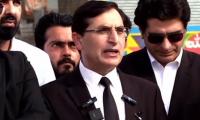A somewhat bumpy democratic transition continues to create uncertainties that allow desperate elements to disrupt the constitutional path to stabilisation. There are ideological, political, strategic and institutional paradoxes that distort political processes and make the state look like a ‘failing state’ – often described so in terms of failures of governance.
What are the ailments that are easy to prescribe and difficult to solve? Pakistan has moved on with all the burdens and damages caused by disparate modes of development and models of governance. Nothing worked – from quasi-elected civilian dispensations, manipulated by the bureaucracy, that failed to even frame a viable constitution to extremely devastating authoritarian models led by the army and populist authoritarians to timid elected dispensations.
Despite the framing of the 1973 constitution, after the military defeat and dismemberment of the country under Gen Yahya Khan, the country suffered at the hands of quasi-civilian and naked military rule by rotation in a perverse khaki and mufti divide. This vicious cycle doesn’t stop and continues to dog the constitutional setup by virtue of the hegemony of the garrison in the most pivotal matters of the state.
There are numerous paradoxes, but let us focus on five that are more crucial: first, the nature and character of the state – whether Islamic or a nation-state. Some political scientists find problematic issues inherent to the Muslim separatist movement that are simplistically exploited by the religious right to make Pakistan an Islamic state, even though it has resulted in sectarian divides that are so very divisive to building a unified terrestrial nation-state which they reject due to their Islamic universalism.
The other view is of a modern nation-state based on geographical sovereignty, which is regardless of its citizens’ religions but historically rooted in the multi-ethnic nature of the country. This fundamental ideological paradox remains to be resolved. The compromise among various ideological schools in framing the 1973 constitution or reference to the founders’ intentions does not help reach a logical conclusion. That has resulted in the failure of the state to evolve an alternative national democratic narrative to counter an Islamic universalist view (ummah without borders divided by sectarian militias) represented by all religious and extremist terrorist outfits.
Even the so-called politically liberal parties remain confused on ideological parameters as religious parliamentary parties resist becoming democratic unlike their Christian counterparts in Europe. Hence, Pakistan remains a mix of religious and secular entity, having failed to resolve its ideological dualism.
Second, the civil-military dichotomy: this has continued to hinder a smooth transition to a democratic and constitutional order. Over decades of direct and indirect rule, the garrison has emerged as a de-facto power over the direction the state ought to take not just on security and foreign affairs but also on whatever it deems to be in the ‘national interest’. When the parallel power structures continue to collude with the civil part on the receiving end, neither a stable system of governance nor consistency in policies can emerge. This gives the chief of army staff an overriding role over the elected chief executive, even though he remains non-Bonapartist.
The creation of the office of the chairman of the Joint Chiefs of Staff Committee, removal of Article 58-2B of the constitution and the devastating consequences of prolonged military rule in the country could not stop the armed forces from continuing to expand their areas of operation acquisition of national resources. Despite the dismemberment of the country, the military continues to dictate its terms and leaves little space to the civilians, who remain vulnerable to the longer arms of the powers that be.
Third, conflict between the federation and the provinces. Despite the passage of the 18th Amendment, the tension and overlapping between the structures of the federal tier and the federating units continue to generate controversies, conflicts and even insurgencies. The dominance of the centralised structures of the state over the auxiliary structures of the provinces, division of resources, inverted pyramid-like development and the hegemony of a centralised authoritarian establishment continue to mar smooth relations between the federation and its constituent units.
The controversies over the National Financial Commission, lack of functioning of the Council of Common Interests, the ongoing military operation in Balochistan, powers of the Rangers in Karachi and routes and benefits of the China-Pakistan Economic Corridor are some of the manifestations of uneasy relations between the centre and the provinces.
Fourth, unequal and unsustainable economic development that results in the concentration of wealth in a few hands at the cost of the marginalisation and pauperisation of the vast majority of dispossessed people and deprived regions. This creates not only social stratification, but also regional disparities. The Ayub model failed; so did Bhutto’s quasi-socialist experiment.
The Sharif model is also flawed; it focuses on eye-catching infrastructure projects while ignoring human resource development and social sectors, health and education in particular. Under increasing debt, higher defence expenditure, falling exports and remittances, the Pakistani economy is going to face a severe balance of payment crisis in the years to come. There is no focus on the demographic surge of youth, which rather than becoming an asset will turn out to be a dangerous liability in the absence of proper education and professional training. As rent seeking and corruption prevail, both manufacturing and agriculture are becoming unviable.
Fifth, over-burdening security designs and a hostile regional environment are going to further exacerbate the internal crisis and increased conflict with all neighbours. It’s not foreign policy that is failing. Rather, it is our flawed and dangerous security paradigms that bring Pakistan into conflict with neighbours and the international community. Civilian governments are not powerful enough to set the course right.
Almost every prime minister who tries to correct the course is either declared a security risk or sidelined. Only geo-strategic compulsions can show us the way out of the quagmire we find ourselves in. There is no alternative to peaceful resolution of conflicts; and without regional economic integration, Pakistan cannot find a way for a secure and prosperous existence.
Instead of quarrelling over frivolous issues and undermining civilian authority, the politicians should focus on fundamental policy issues and mobilise public opinion on alternative programmes. The parties of the old regime, both PML-N and the PPP, had to reform themselves.
Imran Khan’s PTI should come up with a clear manifesto rather than exhausting its energies in putsches. Perhaps, Pakistan will face a serious crisis soon – or it should take a course that steers it out of its five-fold paradoxes.
The writer is a senior journalist.
Email: imtiaz.safma@gmail.com
Twitter: @ImtiazAlamSAFMA
An aeroplane of the national flag carrier of Pakistan is seen in this file photo. — AFPWhile Pakistan considers...
Representational image of a graph depicting various variables. — APP/FileInitiated by the centre and fiercely...
In this picture taken on April 16, 2023, people throng a market area during shopping in Lahore. — AFPOne of the...
Honour crimes also target men. In Sikandar Ali Lashari vs The State, SHC upheld conviction passed by ATC for honour...
If Sindh earmarks Rs20 million per police station, it will cost only Rs10 billion to make them effective first...
A complex and difficult policy environment seems to be highlighted by US’s recent application of sanctions on...







